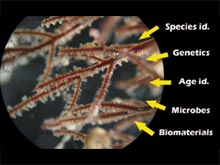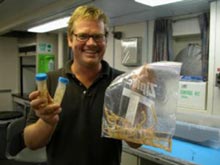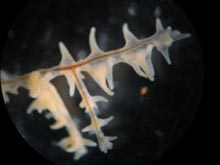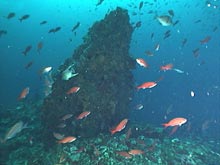
Thick clouds of fish, including creole fish and amberjacks, school around one of the basalt spires at Alderdice Bank. Click image for larger view.
The Two Towers (Mid Depth, not Middle Earth)
September 26, 2003
Sarah Bernhardt
Flower Garden Banks National Marine Sanctuary, NOAA
We arrived at our dive site, Alderdice Bank at the edge of the continental shelf, late yesterday afternoon. The researchers on the Flower Garden Banks National Marine Sanctuary team were giddy with excitement and anticipation as they prepared to put the ROV (remotely operated vehicle) into the water. The team had the opportunity to visit Alderdice Bank last summer, during the 2002 Sustainable Seas Expedition, using the one-person submarine Deepworker. At that time, the team collected hundreds of beautiful digital images and high-quality video, but a limited amount of physical samples.
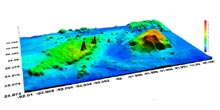
Alderdice Bank features two towers of basalt over 60 ft tall, and one large elevated region to the east, which is home to sponges, gorgonians, and leafy green algae. Click image for larger view.
The Deepworker was equipped with an open-topped crate at the front and a single manipulator arm, allowing heavier objects that would not float out of the crate to be collected during the course of the dive. The beauty of using the Sonsub ROV is that we are able to focus on collecting all varieties of specimens: rocks, invertebrates, algae, and, if possible, fish. As was noted in yesterday’s log, the fish have proven to be elusive thus far!
Alderdice Bank is a relatively small site with high-quality bathymetric data. We began our first ROV dive around 4 pm yesterday, with Flower Garden Banks NMS manager G.P. Schmahl and research coordinator Emma Hickerson in the ROV operations van, directing the Sonsub crew during the dive. Back in the main science lab, the rest of the scientists were circled around the video screen, recording what was seen on a computer spreadsheet, and occasionally calling the ROV pilots and suggesting that they collect a sample of something unusual. As the ROV descended upon the first peak (northernmost of the two peaks) at 200 ft depth, we saw a school of at least 100 amberjacks spiraling around the top of the peak, and hundreds of creole fish schooling around the narrow top (about 15 ft across).
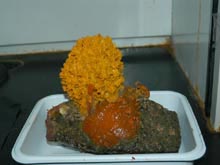
This piece of basalt, collected at 162 ft depth, was home to 5 species of sponge, one small crab, a colony of pin-sized tubeworms, some unusual mollusks, and some coralline algae. Click image for larger view.
We had about 6 hours of successful ROV operations at Alderdice Bank. We circled around the northern peak, collecting a yellow crinoid, a black coral colony, several rocks encrusted with sponges, and a lovely orange gorgonian. Around 8 or 9 pm we directed the ROV to head over the less physically dramatic, but biologically diverse, eastern portion of the bank.
The most striking thing we noted about this area was the lack of fish. The bottom was somewhat muddy, and the rocks were covered by many more sponges and gorgonians. The ROV survey made its way around the base of the eastern peak, recording some interesting orange mound sponges and a variety of gorgonians. The rock on this part of the bank was less angular than what we saw at the spire. At this eastern feature, the rock was much more eroded, and host to a notably denser community of encrusting organisms.
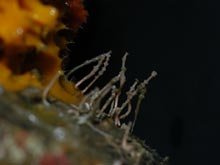
These tube worms are the size of pins and were found at the base of the orange sponge that was collected on a very dense and heavy piece of basalt. Click image for larger view.
Unfortunately, an electrical problem in the ROV cut the dive a bit short.
The science party got up this morning at 7 am, full of anticipation to resume ROV operations, but by 10 am the ROV electrical failure of last night was still unresolved despite the constant work of the Sonsub crew. They determined that parts were needed to get the massive sub back in the water. A ship will meet us tomorrow with the parts, and we hope to resume surveying and sampling by tomorrow night. With the sub on deck, there is ample time to work on video footage and sample processing. The team will also utilize the shipboard Seabeam system to acquire multibeam data in regions selected for their potential to harbor deep-water coral communities, and that currently lack high-resolution maps. Today, we will use the time to complete a multibeam survey at Parker Bank (12 mi south of Alderdice Bank). Then the plan is to transit to Sidner Bank to acquire multibeam data, starting at the edge of the continental shelf and moving down to the slope.
We will sign off for now and hope for some exciting discoveries to share with you tomorrow!
Note: Bathymetric charts of the shelf edge reefs of the northwestern Gulf of Mexico are available online at http://walrus.wr.usgs.gov/pacmaps/wg-index.html ![]()
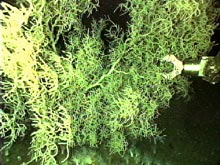
The arm of the ROV Innovator as it reaches to sample a deep-sea coral colony in the Gulf of Mexico at 1,178 ft. Click image for larger view.
The Life Cycle of a Specimen
Peter Etnoyer
Marine Conservation Biology Institute
Deep-sea corals have been around for a long time. They range from the Equator to the poles, and from mid depths to the abyss (2 mi deep). Only recently, however, has scientific and public interest in these corals grown. The community of deep-sea coral researchers is small, but growing fast. Many questions remain unanswered. How deep can they grow? How old are they? The expertise to answer these questions is spread all over the world. I work with a broad range of experts in several disciplines, states and countries, trying to gather information pertinent to U.S. researchers seeking to know more about deep- sea corals in our national waters. The science crew here includes microbiologists, coral biologists, geologists, icthyologists, geochemists, botanists, marine ecologists, and mission managers. We all work together as a team. We collect specimens from the sea floor to better understand life and survival in marine environments.
Deep-sea collecting has changed considerably since the 1970s. Marine biologists once relied heavily on trawl gear to collect benthic (bottom associated) marine organisms. Trawl gear uses a heavy net dragged across the sea floor to gather marine creatures that grow upon and live in the rocks and mud. Today, conservation-minded scientists spurn trawling whenever possible, especially in commercial fisheries. This type of collecting can cause serious damage to delicate organisms, and serious damage to the sea floor. Modern technology uses manned submersibles and remotely operated vehicles, which allow scientists to be much more selective in their sampling methodology.
When we collect a deep-sea coral sample these days, we first document the live specimen using video and still cameras. This is a significant improvement over the broken, dead coral fragments of yesteryear. We use video to learn about deep living corals, their surrounding habitat, and associated species. We can tell whether a coral prefers to live in mud (a soft substrate) or on a rock (a hard substrate).
Other things can only be learned in the laboratory. I like to send samples to many different experts. I send some to the Smithsonian Institution in Washington, DC, for positive species identification, some to a colleague in California who studies age and growth, and some to colleagues in Germany who study biomaterial science. Others I keep for my own research.
NOAA’s Office of Ocean Exploration is sponsoring the Marine Conservation Biology Institute (www.mcbi.org ![]() ) to develop protocols, or standards, that will enable us to answer many questions with a single organism. These protocols allow scientists in one field to share samples with scientists in another. My job on this cruise is to test these protocols. I do this by collecting and preserving deep-sea corals for a variety of researchers. Advances in these techniques will minimize the impacts of scientific collecting, while maximizing the number of questions we can answer.
) to develop protocols, or standards, that will enable us to answer many questions with a single organism. These protocols allow scientists in one field to share samples with scientists in another. My job on this cruise is to test these protocols. I do this by collecting and preserving deep-sea corals for a variety of researchers. Advances in these techniques will minimize the impacts of scientific collecting, while maximizing the number of questions we can answer.
When a deep-sea coral comes on board, small pieces are clipped off and preserved in ethanol. These are called wet samples. A larger branched piece is frozen, and the remainder is dried out and cleaned of living tissue. These are referred to as dry samples. I examine the living tissue under a microscope, photograph the polyps, and dry the remaining skeleton for carbon dating or museum display. One of the wet samples will go to an expert in species- level identification, and the other to a scientist with experience in genetics. The frozen sample will go to a laboratory for observation under a scanning electron microscope to observe the bony, odd-shaped sclerites found in the living tissue. These tools aid in species identification. The dried pieces are sent off to another laboratory for radiocarbon dating. This tells us the age of a coral colony, and how fast it grows. Dried samples are also useful to people who study things like bioerosion, the way sponges and diatoms bore into coral fragments and degrade their skeletons, and biomaterials, an applied form of chemistry that creates new materials from deep-sea compounds.






















